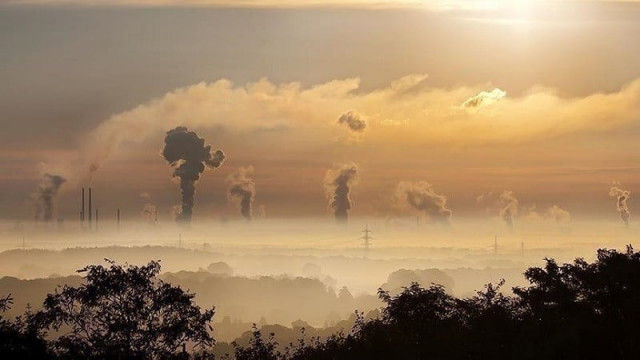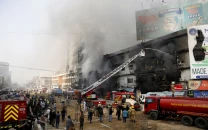Rising temperatures trigger water, food insecurity in Pakistan, India
Climate change also threatening biodiversity in both countries

Rising temperatures, a direct result of climate change, are aggravating water, food, and biodiversity insecurity in Pakistan and India, which may worsen in years to come, said environmentalists based in the region.
An intense heatwave is currently sweeping through the two nuclear-armed neighbors with temperatures hitting 51 degrees Celsius in Pakistan and 49 degrees Celsius in India.
With forecasts predicting that the wave will keep up the heat through the coming days, environmentalists caution that the soaring temperatures will speed up the melting of glaciers, which would ultimately damage crops and pastures while further shrinking wetlands.
"Already melting glaciers are the primary target of climate change, mainly the rising temperatures, which will lead to acute water shortages and subsequently, hit agriculture and biodiversity in the region," Ashiq Ahmad Khan, an environmentalist based in Peshawar, northwestern Pakistan, told Anadolu Agency.
Apart from that, he went on to say, millions of people in the region, mainly in mountainous areas, who rely on livestock, are taking a toll due to the climate-induced destruction of pastures.
Mahesh Palawat, the head of India's private weather agency Skymet, told Anadolu Agency that events like unusual temperatures in the country are the result of climate change.
"Now, because of the western disturbances, there has been some relief," he said, adding that pre-monsoon weather activities are expected to start soon.
Palawat said India's northwestern and central regions were badly impacted due to the heatwaves, which also triggered power outages and a water crisis in many parts.
In the capital New Delhi, lakes and other bodies of water have started drying up, leading to complaints of a water shortage.
Warmest March and April
Sardar Sarfraz of the Meteorological Department of Pakistan said the ongoing heatwave was "unusual" due to its early arrival.
"It came over two weeks before the expected arrival because of climate change, in the larger picture," said the chief meteorologist.
Speaking to Anadolu Agency, he noted that, March and April had seen historically high temperatures with respectively 62% and 72% less rainfall than usual.
Pakistan and India are among the top 10 most vulnerable countries to climate change.
The severity of sea storms and cyclones has also increased in both countries due to climate change over the past 10 years.
Read Pakistan faces 100% high chances of setting new heatwave records
Apart from water stress and glacial melting, he said, the monsoon season is shifting, directly impacting South Asian countries' agricultural output.
India, the second-largest wheat producer in the world, banned staple exports last week, citing a risk to food security and soaring prices.
Despite having one of the world's largest irrigation systems, Pakistan is an importer of wheat, lintels, and other staples as its agricultural lands shrink due to a string of factors ranging from massive floods to drought, as well as the country's increasing housing crunch.
In northeastern Punjab and southern Sindh provinces, increasing populations and housing needs have in recent years turned large swathes of green lands into concrete jungles, not only in the big cities but in small districts as well. Both regions are considered the country's two main bread baskets.
Also, more than 2 million people were displaced by floods that inundated a fifth of the country in 2010, triggering mass migration to cities from rural Pakistan.
Of that figure, almost 70% did not return to their towns and villages, permanently settling in the big cities to make a living as their old homes and farmlands were destroyed, according to the Ministry of Climate Change.
In India, massive rains and floods displace tens of thousands of people every year, in addition to damaging large swaths of agricultural lands.
More heatwaves expected
A State of the Climate report from the UN World Meteorological Organization (WMO) has warned that the region should now expect a heatwave that exceeds record temperatures seen in 2010 once every three years.
Without climate change, it added, such extreme temperatures would occur only once every 312 years.
Heatwaves are common across the two countries in May, June, and July. But, summer came early this year, bringing temperatures to new highs in March.
According to the UN report, climate change is driving the intense heat, making record-breaking temperatures 100 times more likely.
Read more Heatwave to persist till May’s end
The report is based on a heatwave that hit northwestern India and Pakistan in April and May 2010, when the region saw its highest average temperatures since 1900.
If climate change follows the trends predicted in the study, India and Pakistan can expect similarly high temperatures virtually every year by the end of the century.
According to Ravindra Khaiwal, an environmentalist from the northern city of Chandigarh, the WMO study raises the urgency for climate change adaptation and mitigation, specifically in emerging economies like India.
Speaking to Anadolu Agency, he said that despite relatively high economic growth, New Delhi still needs work to do on achieving "zero hunger."
"Under the changing climatic condition, food security should be the top priority for the country's development efforts and to reduce hunger and malnutrition," he said.
Some evidence, he suggested, highlights that rice and wheat in the Indo-Gangetic lowlands, sorghum and potato in West Bengal, and sorghum, potato, and maize on the southern plateau would see diminished productivity in the coming years.
However, he added, soybean, groundnut, chickpea, and potato yields may increase in Punjab, Haryana, and western Uttar Pradesh.
Adaptation
The Indian Health Ministry has already released a health adaptation plan for heat and pollution-related illnesses. These efforts were part of the country's national action plan on climate change and human health.
"India is doing reasonably well in the prediction of heatwaves. However, considering its large population living in rural areas, we need to focus on them, including the marginalized and vulnerable population," Khaiwal said.
"Countries like Pakistan, which have a very minor share in the destruction of the environment, cannot do much to minimize its impact. What we can do is to prepare for adaptation," said Khan, the Peshawar-based forester, for his part.
"It means we should reduce and manage the consumption of food to cope with food security in the near future or equip ourselves to handle the diseases caused by intense heat and other climate change effects," he maintained.



















COMMENTS
Comments are moderated and generally will be posted if they are on-topic and not abusive.
For more information, please see our Comments FAQ